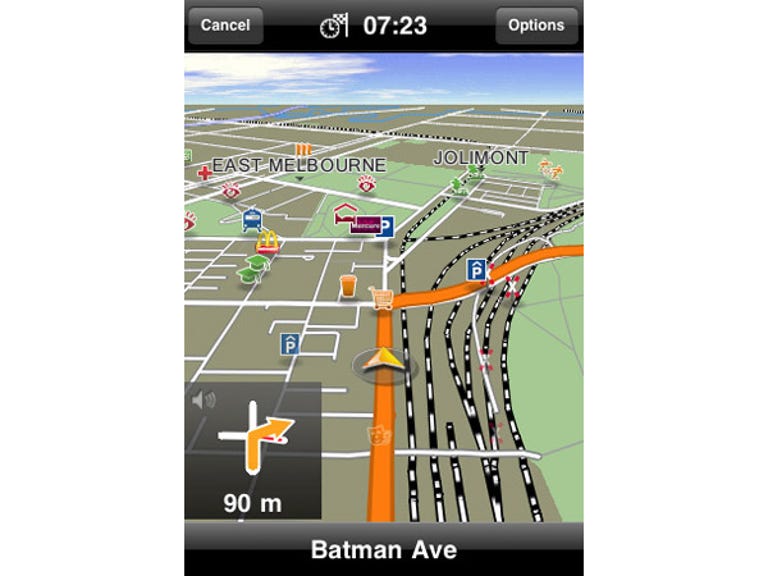 Why You Can Trust CNET
Why You Can Trust CNET Navigon MobileNavigator for iPhone review: Navigon MobileNavigator for iPhone
With the addition of text-to-speech and the squishing of a few previous bugs, Navigon's MobileNavigator makes sense for the occasional nav use. We still have some reservations about the whole iPhone nav experience, though.
Note: this review is for version 1.2 of MobileNavigator. It now features text-to-speech, automatic day/night mode, point-of-interest calling and iPod controls.
The Good
The Bad
The Bottom Line
Design
At first glance, you might be forgiven for thinking you were using one of Navigon's dedicated GPS devices, then it twigs that there's an iPhone info bar (carrier, signal strength, time and battery status) running along the top. Dive deeper in and other changes become apparent, such as swipe to scroll lists, smooth screen change animations, and multi-touch for zooming in and out.
While the standard iPhone keyboard is more than fine for destination entry when the iPhone is handheld, the keys aren't quite big enough when it's mounted on the windscreen. Likewise, many of the buttons feature text that's too small and hard to see when used in a car, such as those at the bottom of the main menu for favourites, recent addresses and contacts.
Fast typers may find the predictive text chugging away in the background a hindrance, as it slows down the keyboard's reaction times. Although, if you're anal enough to enter addresses for your contacts in the iPhone's phone book, navigating your way to their doorsteps is but a few finger taps and swipes away. Points of interest with phone numbers can be called directly, but after the call is done you have to wait for MobileNavigator to restart — we clocked start-up time to around 11 seconds — before entering in the address again; a similar thing happens when you take a call whilst driving.
The main map screen isn't quite as dark as the black and grey menus, but it's still pretty dour and by default it's cluttered up by lots of little points-of-interest icons, which at times can be either useful or annoying. The screen reorientates itself between landscape and portrait mode automatically, with decent grace and pace; and switching between day and night modes is now (finally) automatic. With the iPhone mounted on the windscreen, viewing the screen on bright sunny days is a constant battle against reflections. Pop on a pair of sunnies and it becomes nigh on impossible to see anything.
Features
As noted above, the recent upgrade to version 1.2 has swelled MobileNavigator's feature list quite a bit, although traffic messaging and warnings for speed and red light cameras, as well as school zones, are still notable for their absence.
Although not enabled by default (you need to first enable iPod Control in the settings screen), there's a tiny iPod icon lurking in the bottom right of the main map screen. Through this a cut-down iPod interface can be brought up where you can add songs, albums and artists to a playlist. Oddly, Cover Flow isn't available and the song list only displays in portrait mode. When tunes are being played, the system will softly lower the music volume during verbal instructions. While the iPod's speakers trump many a mobile phone's for music it should only be used as a last resort.
With the recent upgrade, the verbal instructions have not only gained text-to-speech, giving it the ability to pronounce street names, but the clipping issues of version 1.0 have been given the old heave-ho. There's only one female voice on offer; intriguingly, she's still a little bit too husky for our liking over the iPhone's speakers, but surprisingly clear via an auxiliary cable. Some short names are difficult to discern, but pronunciation is generally OK: prominent Aboriginal names, like Illawarra and Parramatta, come out just fine, while some Anglo-Saxon names, like Bourke (Bork in Navigon-speak), are mispronounced to head-scratching effect.
A feature that we first saw in Navigon's current season nav apps has crept through into the iPhone app. Instead of announcing street names, MobileNavigator will outsmart itself and instruct you to, say, "turn left towards Parramatta" — which, if we were being pedantic, could be any non-dead end street. Also, the suburb referenced is usually not in that direction and not the one referenced on a large road sign (if by coincidence one happens to be around).
Performance
MobileNavigator comes loaded with the latest Navteq maps for Australia. As we've noticed with other GPS apps and devices featuring Navteq's maps, turn restrictions for many roads — including both major and minor roads in Sydney — are non-existent. This leads to many not-quite-legal and some impossible right turn instructions, as well as quite a few illegal u-turns when you deviate from the chosen path.
Lane guidance and junction view, where the screen is taken up by a graphic with the appropriate lanes and signs, is limited to highway and motorway exits. Route calculation is par for the course, that is not exceptionally quick, but it shouldn't be a hindrance unless you're heading from Sydney to Perth in one go.
Like every other iPhone navigation app we've tested thus far, performance in the CBD is appalling with signal drop outs and mixed up placements the norm, rather than the exception. In the suburbs signal drop outs or, more likely, confused locations are not infrequent occurrences; on stand-alone navigation devices, this rarely, if ever, happens. Car tracking is OK when you stick to the app's preferred route, but should you take a wrong turn it takes a good 15 to 30 seconds to twig before attempting a route recalculation.
Conclusion
With the addition of text-to-speech and the squishing of a few previous bugs, Navigon's MobileNavigator moves from just OK to good. We still have some qualms about the iPhone navigation experience, like poor GPS performance and it's usefulness on sunny days.


